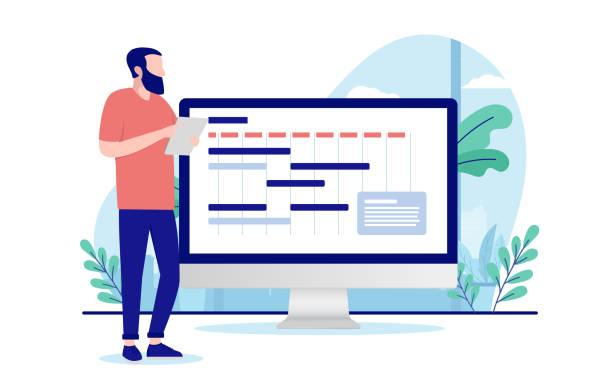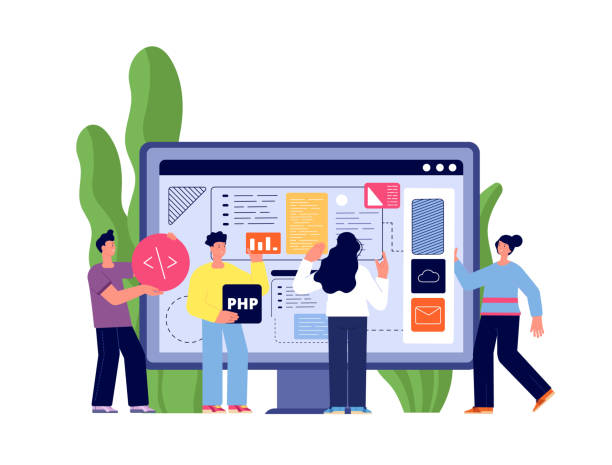Introduction to the Importance of Multilingual Website Design

In today’s world, where geographical boundaries have blurred due to the internet, online presence has gained double importance for businesses and organizations.
With the increasing number of internet users worldwide, the need to communicate with audiences from different cultures and languages is felt more than ever.
This is where the concept of #multilingual_website_design shows its importance.
Designing a website that can be presented in multiple languages is not just a choice, but a strategic necessity for accessing #global_markets and expanding the scope of activities. This approach allows you to more effectively introduce your products and services to international audiences and create new business opportunities.
Increasing #language_diversity on the website means increasing the chance of your message being seen and understood by a wider range of users who search in their native language and prefer to read content in their mother tongue.
This is a fundamental step in building stronger #cross-border_communications and fostering loyalty among foreign customers.
In fact, ignoring the multilingual capability of a website means losing a significant portion of the potential global market.
A multilingual website is a powerful tool for increasing brand penetration and consolidating position in international competitions, as it demonstrates respect for the culture and language of the target audience and this in itself can create an engaging and positive user experience.
Is your current corporate website not reflecting your brand’s credibility and power as it should? Rasawb solves this challenge for you with professional corporate website design.
✅ Increased visitor credibility and trust
✅ Targeted attraction of more customers
⚡ Click for free consultation!
Challenges and Opportunities in Multilingual Website Design
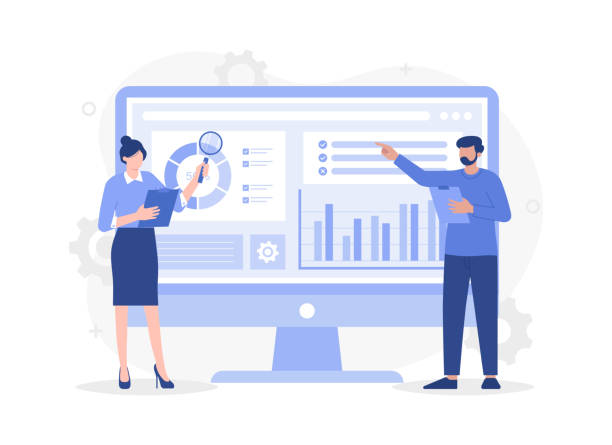
Despite its many advantages, multilingual website design also has its specific challenges that must be addressed carefully. One of the main challenges is content management; ensuring that all language versions remain up-to-date and consistent requires a robust and efficient content management system.
Translation is not just a copy-paste; it requires localization, which includes adapting terminology, culture, currency, and even the display format of dates and times.
This stage is specialized and requires native localizers.
Other challenges include search engine optimization (SEO) for each language; keywords in different languages may be completely different and require separate research for each target market.
Technical issues such as correctly implementing Hreflang tags and choosing the appropriate URL structure can also be complex.
However, the opportunities arising from multilingual website design are immense.
Accessing new markets, increasing website traffic, improving international SEO, and strengthening brand credibility globally are just some of these benefits. A multilingual website allows you to communicate with your audience in their native language, leading to increased conversion rates and customer loyalty.
This is a comprehensive guide for businesses looking to go global and helps them fully leverage the benefits of the global web.
Choosing the Right Platform and Technical Approaches

Choosing the right platform for multilingual website design is one of the key decisions that impacts the long-term success of your project.
Content Management Systems (CMS) like WordPress with plugins such as WPML or Polylang, Drupal which has powerful multilingual capabilities, and Joomla, are popular options.
Each of these platforms has its own advantages and disadvantages, and their selection depends on your team’s needs, budget, and expertise.
In addition to platform selection, technical approaches for implementing language versions are also very important.
The three main approaches are:
- Subdomains: such as fr.example.com or de.example.com.
This method helps with local SEO and offers good flexibility in server and hosting management. - Subdirectories: such as example.com/fr/ or example.com/de/.
This is the most common and recommended method by Google for many businesses, as it transfers the main domain’s authority to the language versions. - Country Code Top-Level Domains (ccTLDs): such as example.fr or example.de.
This method is suitable for large businesses with high budgets that want a strong and separate presence in each country.
However, it is more complex in terms of management and cost.
An educational perspective in this area is that each technical approach has a different impact on SEO, user experience, and content management. One must choose the best option based on the business strategy and target markets.
For example, if your primary goal is to focus on a specific foreign market, a ccTLD might be a better choice.
These technical decisions form the foundation of a successful multilingual website design and require careful analysis.
Comparison of Technical Approaches for Multilingual Websites
| Feature | Subdomain (e.g., fr.example.com) | Subdirectory (e.g., example.com/fr/) | ccTLD (e.g., example.fr) |
|---|---|---|---|
| SEO Complexity | Medium (requires separate management) | Low (most domain authority) | High (requires building separate authority) |
| Ease of Management | Medium (can be on separate servers) | High (all under one main domain) | Low (managing multiple domains) |
| Cost | Medium (may require separate hosting) | Low (often included with main host) | High (purchasing and renewing multiple domains) |
| Local Presence | Good | Medium | Excellent |
Importance of Quality Translation and Content Localization

Quality translation and content localization are the backbone of a successful multilingual website design.
This process goes beyond word-for-word translation; it involves adapting content to cultural nuances, local idioms, units of measurement, date and time formats, and even colors and images.
A poor translation can damage your brand’s credibility and even lead to misunderstandings. In contrast, localized content not only conveys your message correctly but also shows your respect for local audiences, which in turn increases trust and loyalty.
For example, a successful website should be able to display phone numbers with international dialing codes, addresses in local formats, and prices in local currency.
This explanatory and specialized approach should be carried out by native localizers who, in addition to mastering the language, are also fully familiar with the target culture and markets. Using machine translation tools alone is not recommended, as they are unable to understand cultural nuances and local idioms and may lead to unnatural or even humorous translations.
Content that might be misunderstood for foreign users should be carefully translated and localized to prevent any ambiguity or misunderstanding.
Investing in quality translation and localization is a smart investment that yields high returns in attracting and retaining international customers and helps strengthen your branding and global presence.
Is your online sales not as expected? With Rasawb, solve the problem of low sales and poor user experience forever!
✅ Increase conversion rate from visitor to customer
✅ Create an enjoyable user experience and increase customer trust
⚡ Act now for a free consultation!
SEO Optimization for Multilingual Websites

Search Engine Optimization (SEO) for a multilingual website design has its own complexities, but if done correctly, it can attract significant traffic from international markets.
The most important step in multilingual SEO is the correct use of Hreflang tags.
These tags help search engines like Google identify different language versions of a page and ensure that users receive content in their appropriate language.
Incorrect implementation of Hreflang tags can lead to duplicate content issues. In addition to Hreflang, keyword research for each language is also crucial.
Keywords that are effective in one language may not be applicable or may have a different meaning in another language.
Therefore, conducting comprehensive keyword research for each target market, including dialects and local idioms, is essential.
The educational nature of this section is very important, because without a proper understanding of international SEO principles, efforts to attract global traffic will be fruitless. Using Google Search Console to determine geographical targeting for each language version is also an important step.
This tool allows you to tell Google which geographic region or specific language each version of your website is intended for.
Also, internal linking between different language versions (while adhering to Hreflang tags) and building backlinks from reputable local sites helps strengthen your international SEO.
This process is analytical and specialized and requires continuous monitoring and updates to ensure your site performs well in global rankings.
User Experience and User Interface in Multilingual Website Design
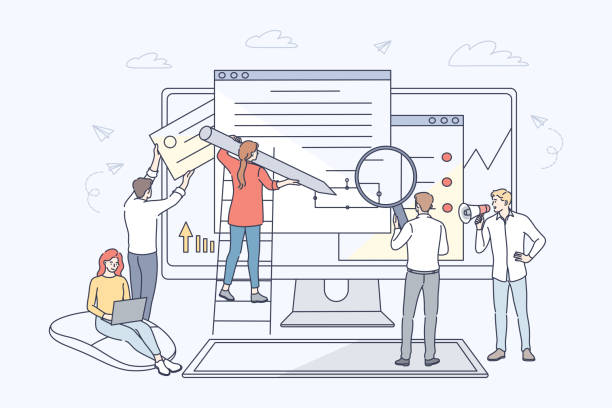
User Experience (UX) and User Interface (UI) are particularly important in multilingual website design.
A successful multilingual website must not only be technically flawless but also provide an enjoyable and seamless experience for users from all over the world.
One of the most important elements is easy and accessible language selection. The language switcher should be placed in a prominent and visible location (usually in the header or footer) and clearly displayed (e.g., with a country flag or ISO language code).
Also, it must be remembered that some languages are read from right-to-left (RTL), such as Persian and Arabic, while many others are left-to-right (LTR).
The user interface design must have the ability to automatically adapt to the language’s reading direction so that text, images, and element layouts are displayed correctly.
This is a very important guidance point that many designers might overlook. Also, fonts and text sizes should be chosen to be legible in all languages.
Some languages, such as Chinese or Japanese, have very different characters and require their specific fonts.
An engaging user experience means that the user can choose their desired language without any problems and easily navigate the site. Ignoring these details can lead to user dissatisfaction and website abandonment.
Multilingual website design should be based on in-depth research into the cultural habits and preferences of target users.
This specialized approach not only enhances usability but also helps build deeper connections with global audiences.
Content Management and Updates in Multilingual Websites

Content management and continuous updates in a multilingual website design can be one of the most complex aspects.
Maintaining content consistency and integrity across all language versions requires a precise strategy and appropriate tools. Imagine adding a new product page to the website or needing to update pricing information; these changes must be applied quickly and accurately in all languages.
Without an efficient content management system, this process can be very time-consuming and prone to errors.
Translation Management Systems (TMS) and multilingual plugins in CMSs play a vital role in this area. These tools allow content to be managed centrally, translators to easily access original content and upload translated versions, and changes in one language to be quickly reflected in other languages.
This is a complete explanation of the necessity of a robust management system. Also, defining a clear workflow for content creation, translation, review, and publication for each language is essential.
This process should include clear responsibilities for each team (content team, translation team, technical team).
Furthermore, it should be noted that news content or special events may require simultaneous publication in all languages, which requires precise coordination.
Multilingual website design, in terms of content management, requires a specialized perspective to ensure that no version of the content remains outdated or incorrect.
This approach ensures that users, regardless of the language they view the site in, receive accurate and up-to-date information.
Comparison of Multilingual Content Management Strategies
| Strategy | Advantages | Disadvantages | Use Cases |
|---|---|---|---|
| Manual Management | Full control, suitable for small sites | Time-consuming, error-prone, difficult to scale | Very small websites with static content |
| Using CMS Plugin | Good integration with CMS, relative ease | Technical limitations, plugin dependency | Most medium websites (e.g., WordPress) |
| Translation Management System (TMS) | Automation, advanced workflow, translation memory | High cost, initial setup complexity | Large companies with dynamic and high volume content |
Performance Measurement and Data Analysis in Multilingual Websites
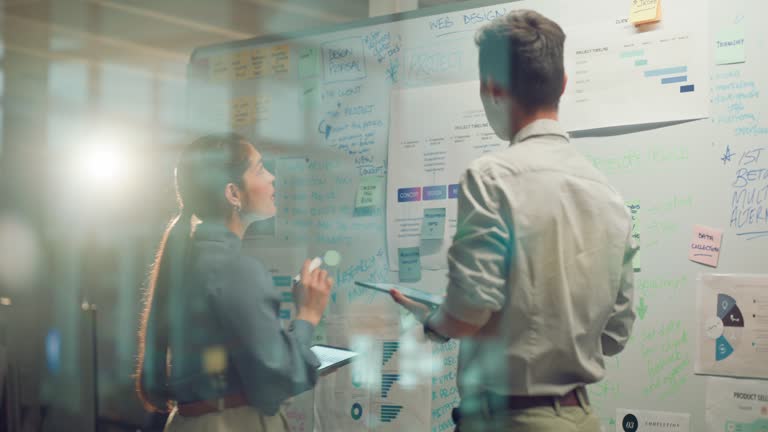
After multilingual website design and its launch, the next crucial stage is performance measurement and data analysis.
Without proper analysis, you cannot understand how successful your multilingual website has been in achieving its international goals. Tools like Google Analytics or other analytical platforms allow you to monitor the performance of each language version separately.
Metrics to consider include: inbound traffic from each language/country, conversion rates for each language version, user dwell time, bounce rate, and keywords users use to find your website in different languages.
This analytical approach helps you identify the strengths and weaknesses of each language version and adjust optimization strategies based on real data. For example, if you observe that the conversion rate on the German version of your website is low, you might need to review its translation, localization, or user experience.
Accurate data analysis can resolve content that raises questions and show you which markets have the most growth potential.
Also, monitoring international SEO errors in Google Search Console is crucial, such as Hreflang tag issues or 404 errors for translated versions. A regular report on the multilingual performance of the website allows you to make data-driven decisions and ensure that your investment in multilingual website design yields the best possible returns.
Is your company’s website not as professional and reliable as it should be? With specialized corporate website design by Rasawb, create an online presence that reflects your credibility and attracts more customers.
✅ Building a powerful and professional image for your brand
✅ Converting visitors into real customers
⚡ Get a free consultation now!
Security and Maintenance in Multilingual Website Design

Security and regular maintenance are integral parts of the lifecycle of any multilingual website design.
Like any other website, multilingual websites are also exposed to security threats such as malware attacks, phishing, or DDoS attacks.
The difference is that due to the increased complexity in managing multiple language versions and the potential use of plugins or third-party translation systems, vulnerabilities may increase.
Therefore, implementing strong security protocols, such as using SSL certificates, regularly updating the platform and all plugins, and regularly backing up all language versions, is of paramount importance. A secure website not only protects your and your users’ information but also helps with SEO rankings. In addition to security, regular maintenance is also essential to ensure the correct and optimal performance of the website.
This includes checking for broken links in all languages, optimizing the database, monitoring page load speeds (which may vary for each language and geographic region), and ensuring compatibility with different browsers.
This is an important explanation regarding the continuity of website performance. Also, updating outdated content in all languages and ensuring the accuracy of translations are part of content maintenance.
This specialized and time-consuming process is necessary to maintain the credibility and optimal performance of your multilingual website.
Ignoring security and maintenance can lead to serious damage, data loss, and reduced user trust, ultimately leading to the failure of your multilingual website design.
The Future of Multilingual Website Design and New Trends

The future of multilingual website design is evolving with the emergence of new technologies and changes in user behavior.
One of the most important emerging trends is the use of Artificial Intelligence (AI) and Machine Learning (ML) in content translation and localization. Although machine translation cannot fully replace human translators yet, significant progress has been made in its accuracy and quality.
These technologies can accelerate the translation process and reduce costs, especially for high-volume content.
Also, the growth of voice search and smart voice assistants creates new challenges for multilingual SEO. Voice keywords are usually longer and more conversational and require new approaches in keyword research and content creation that must be localized for each language.
The news content in this area also shows that multilingual web development is moving towards more personalization and a more immersive user experience. Augmented Reality (AR) and Virtual Reality (VR) technologies may also play an important role in the future in providing multilingual content and greater user immersion.
This creates a thought-provoking question regarding the future of digital interactions.
On the other hand, international SEO standards are expected to become more complex by search engines, which will require more specialized and up-to-date approaches in multilingual website design.
It will be engaging to see how these technologies will ultimately change how we interact with the global web and provide new opportunities for businesses and users worldwide.
Frequently Asked Questions
| Question | Answer |
|---|---|
| What is multilingual website design? | It is the design of a website whose content is available to users in several different languages, so that users can choose their desired language. |
| Why is a multilingual website important? | To access international audiences, increase website traffic, improve user experience for non-Persian speaking visitors, and expand business into global markets. |
| What are the benefits of having a multilingual website? | Increased international SEO, attracting new customers from different countries, enhancing business credibility and professionalism, and reducing bounce rate by providing understandable content. |
| What are the methods for implementing a multilingual website? | Using subdirectories (e.g., example.com/en/), subdomains (e.g., en.example.com), or separate country code top-level domains (ccTLDs) for each language (e.g., example.com and example.de). |
| Which URL structure is best for international SEO? | Subdirectories (e.g., example.com/en/) are often preferred for SEO due to the consolidation of the main domain’s authority, although each method has its own advantages and disadvantages. |
| How does a multilingual site affect SEO? | By providing content in different languages, the site appears in local search results for those languages, click-through rates and traffic increase, and the overall domain authority improves. Correct use of hreflang tags is very important. |
| How is content translation managed? | One can use professional translators, machine translation tools (with human editing), or Content Management Systems (CMS) with built-in multilingual capabilities or relevant plugins. |
| What are the common challenges in multilingual website design? | Managing translated content, maintaining design consistency across different languages, compatibility with Right-to-Left (RTL) languages like Persian and Arabic, optimizing SEO for each language, and choosing the appropriate URL structure. |
| How do I manage text direction (LTR/RTL) in a multilingual site? | For Right-to-Left languages (like Persian), you need to apply specific CSS styles to change text direction, element layout, and table direction. This is often done using the ‘direction: rtl;’ property and other related settings. |
| How can users change the site’s language? | Usually by using a button, dropdown menu, or language selector widget clearly placed in the site’s header or footer. Automatic detection of the user’s browser language and offering a language change is also common. |
And other advertising services of Rasawb Advertising Agency
Smart Brand Identity: A professional solution for digital branding with a focus on optimizing key pages.
Smart Marketplace: A combination of creativity and technology for campaign management through marketing automation.
Smart Marketplace: An effective tool for customer acquisition with the help of marketing automation.
Smart Marketplace: A specialized service for campaign management growth based on custom programming.
Smart Direct Marketing: A combination of creativity and technology to increase website visits by optimizing key pages.
And over a hundred other services in the field of internet advertising, advertising consultation, and organizational solutions
Internet Advertising | Advertising Strategy | Advertorial
Resources
Multilingual Website Design StrategyInternational SEO for WebsitesWebsite LocalizationMultilingual Web Platforms
? Are you ready to take your business to the top in the digital world? Rasawb Afarin Digital Marketing Agency, specializing in professional website design, SEO optimization, and comprehensive content marketing strategies, is your guide to achieving great goals. With us, you will have a powerful and lasting online presence.
📍 Tehran, Mirdamad Street, next to Bank Markazi, Kazeroon South Alley, Ramin Alley, No. 6

